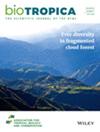Greater Landscape-Scale Forest Cover and Animal-Mediated Seed Dispersal Syndromes Associate With Faster Recovery Rates in Restoring Tropical Andean Forests
Abstract
Evaluating the effect of environmental variation and landscape attributes on the success of active forest restoration is critical to guiding restoration policies and practices. We used a large-scale forest restoration effort to investigate how environmental factors and landscape attributes affected forest recovery along a ~1000 m elevation gradient on the Pacific slopes of Andean tropical montane forests in Ecuador. In 92 plots across five restoration sites, we determined relationships among forest recovery parameters (i.e., species richness, stem density and aboveground biomass accrual) and environmental (i.e., elevation and precipitation) and landscape attributes (i.e., landscape-scale mature forest cover and distance to mature forest). To explore possible mechanisms underlying recovery, we considered the dispersal syndromes (zoochory vs. non-zoochory) of recruited trees and saplings. Forest recovery rates depended mainly on the interaction between site-level forest cover and distance to forest patches. A greater distance to forest patches increased recovery rates at greater landscape-scale mature forest cover but was predicted to decrease rates under low landscape-scale mature forest cover. As stem density and species richness recovery rates for recruited trees and saplings increased, a greater proportion of the surveyed plant stems and/or species associated with zoochory compared to other dispersal types. This clear result suggests that animals in the wider landscape could mediate forest recovery rates. Our findings highlight the value of natural forest remnants as an aid to accelerate montane forest recovery during active forest restoration.

 求助内容:
求助内容: 应助结果提醒方式:
应助结果提醒方式:


